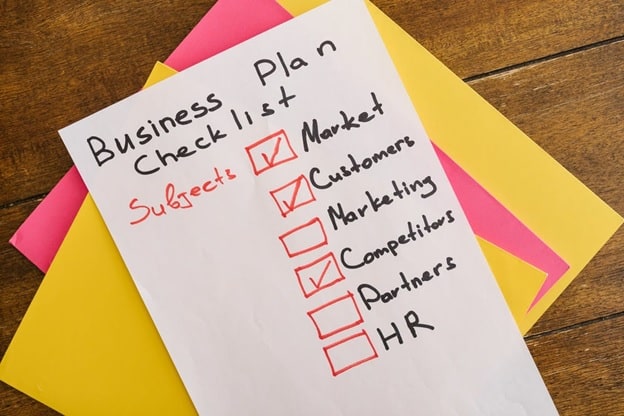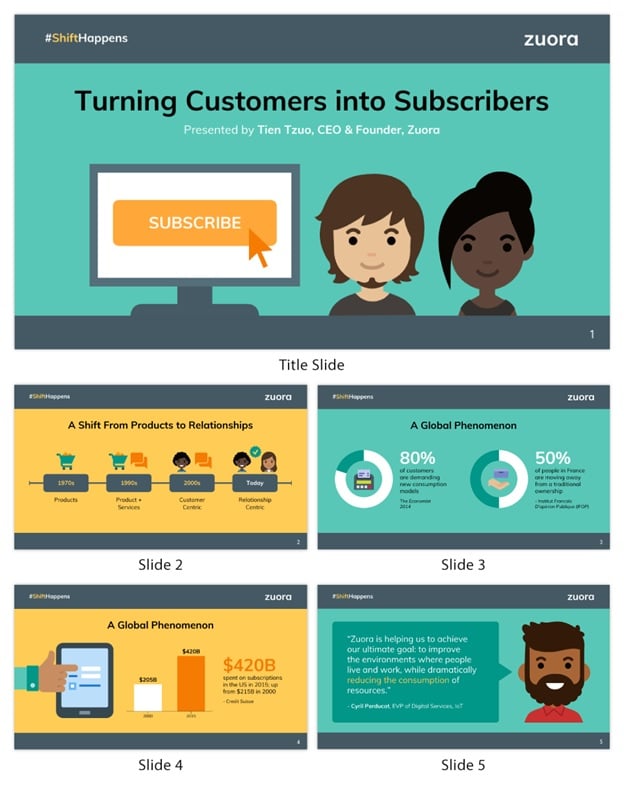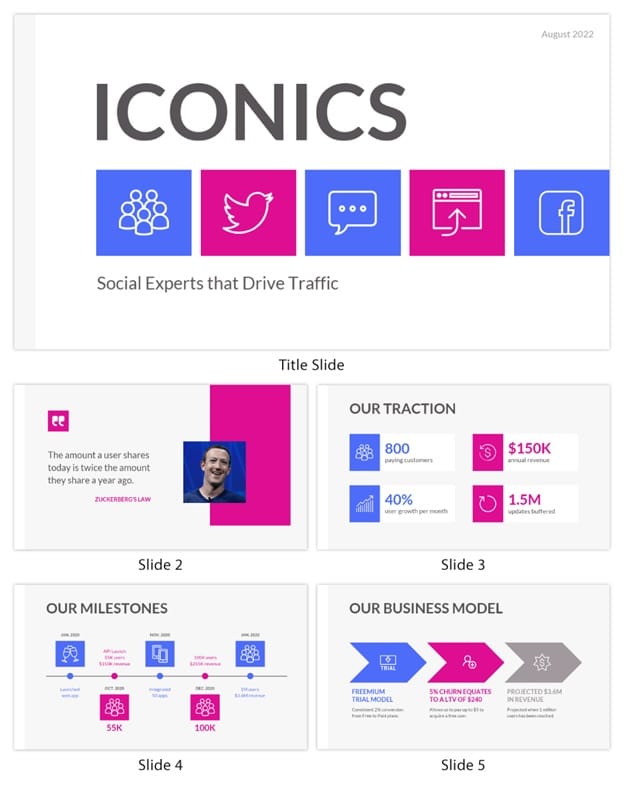If you have a pitch deck, your pitch will be more organized and professional. This article will give you an introduction to pitch decks and offer advice on how to create one. We’ll also show examples of pitch decks from startups that successfully got funding with them!

After this pitch deck guide, you’ll know about pitch decks and how they can help your pitch. You’ll also find templates to follow as well as examples of successful pitch decks from startups that received funding.
Pitch Deck Guide for Startups
Contents
Let’s ask the obvious question: what is a pitch deck? A pitch deck is a presentation slide(s) used during the pitching process where the entrepreneur(s) pitch their business to potential investors and lenders. Your pitch deck design is often the first impression of your company that you give, so it’s important to make a good one!

A pitch deck usually contains:
- Introduction Slide (What problem does your startup solve?)
- Market Overview (The market size & growth, segments/trends within industry, competitors in space)
- Solution (How do you plan on solving this issue? What makes you different from other companies trying to resolve these problems?)
- Team (Who will be working for the startup; experience relevant to the field of expertise needed for success.)
- Financial information (how much funding has been raised by the Founder team thus far, including a pitch for how much you’re looking to raise, what milestones will success look like, and when they will be completed)
- Competition (List the main competitors in the field or market space. This is done so investors can see if there’s already an established market for your startup.)
- Business model (describe the revenue stream, pricing structure, and how it will scale)
- Financial projections (how much funding you need for this startup to succeed. Include a pitch of what success looks like in terms of milestones.)
The pitch deck is also used as leverage during negotiations with investors or potential partners. You can use these pitch decks examples from other successful startups that have received funding by using them as templates when creating your own pitch deck!
Creating a Pitch Deck: How to Make Your Own
Now that we’ve covered why pitch decks are important and some good points to cover within one, let’s go over steps on how exactly to create one with a few great pitch deck examples to refer to!
1) Define Your Target Audience(s)
Make a list of all the people you plan to pitch your startup idea to, who will be attending this pitch, and their job titles. If they’re investors, what type? Venture capitalists? Angels? Net worth requirement for investment desired by the Founder team?)
Think about what information these individual(s) would want most to make an informed decision on whether or not there is potential value within your business.
2) Create A Narrative
Now that we have our notes from above let’s create a strong narrative around them!
This can be done using visual tools such as Venngage, allowing you to easily create infographics and charts to communicate your pitch deck information more easily.

We recommend organizing all important parts into one presentation (Powerpoint, Google Slides, or Keynote). Slide size should be either 16:09 or 16:19 aspect ratios which are great for TV and web viewing.
3) Include Visualizations & Keep It Simple!
The best pitch decks will likely include visualization such as infographics or charts to make it easier to understand key points within your pitch. Keep it as simple as possible, and remember that one of the key points is to pitch your idea, not make a full-blown commercial!

4) Keep IT Short & Sweet
Try for between 12-20 slides. Have you seen an investor pitch deck? It’s an excellent reference for just the right amount of slides to have. Pitch deck length should be concise enough so investors can read through them quickly upon arrival at the session or meeting where the pitch will take place. If there are many visuals included in a pitch deck, aim for a 15 minute pitch time frame instead of 30+ minutes which gets tiring for the audience to sit through.
Ensure you have plenty of time allocated within the pitch slide deck to cover all important parts (see above!) You want your message/story/idea conveyed loud and clear during this timeframe with little room for questions afterward because these answers will be covered in pitch!
5) Practice, Practice & More Practice
Do you know the old saying about practicing something a thousand times to get it right? This couldn’t ring truer during pitch deck template creation. You will eventually find what works for your pitch through trial and error by getting feedback from trusted sources. These can be from mentors or friends/colleagues who have had experience pitching their business idea before going through with actually doing so.
Ensure that the pitch has been practiced many times and the timing is down pat because time can quickly go flying when up on stage speaking nervously under pressure!
6) Don’t Forget to Practice with a Visual Pitch Deck
Visual pitch decks are particularly helpful because they can be looked over beforehand and used as a guide when on stage. Venngage enables you to do exactly this by downloading presentation slides, editing them online using powerful design elements such as infographics & charts, or simply using one of the pre-made templates that we’ve included for your convenience!

7) Include a Call-to-Action
It is crucial that you don’t forget to include some type of call-to-action within the pitch deck. This could be as simple as saying “Please contact me if interested” and providing an email/phone number or even including a link to your business website for further info. Remember, investors want reassurance they won’t invest money into something unworthy of funding, so make sure the pitch stays on point during the presentation!
8) A Pitch Deck is Not a Business Plan
No matter what kind of visuals you choose to use in your pitch, they should never replace the actual written business plan. This document contains every necessary detail about the company and its goals for the future; financial projections, market research & analysis, etc., which means it’s far too important to be taken lightly!
Pitch decks are simply presentation tools that help investors better understand vital components behind an idea or product. In addition, it can provide further incentive by allowing them to see how well researched the pitch truly is.
When creating pitch decks, keep all these tips in mind; networking is key here, so don’t exclude any crucial details within their PowerPoint/keynote/SlideShare, etc. Make sure everything looks nice but also reads well (and flows logically). Lastly, remember what visuals will look like on-screen and how pitch timing will go with these slides (there’s nothing more frustrating than having to rush through your pitch because of time constraints).
Wrapping Up
In summary, pitch deck creation can be a daunting task but should not be overly complicated or time-consuming. Make sure the pitch is prepared ahead of any pitch session/meeting and effectively conveys your message. Hence, you stand out from other startups! With help from sites such as Venngage, pitch decks will become easier to create with no need for design experience at all!
Follow the tips above & get started creating your own pitch deck today with Venngage!
Leave a Reply